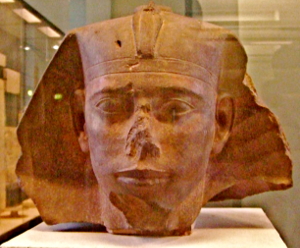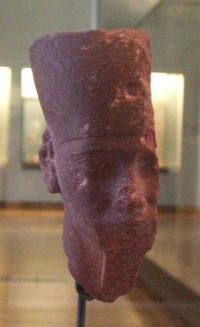
Djedefre (“Enduring like Re”) ruled during the fourth dynasty of ancient Egypt. He was also known as Radjedef. He was the son of Khufu, or possibly his brother. It is sometimes suggested that he was the child of a lesser queen who killed Crown Prince Kawab, his brother and the rightful heir to the throne, and married Khawab’s wife Hetepheres II (who was also his half sister) to cement his position. This is, however, unsubstantiated.
He was also married to Khentetka and had at least four sons: Setka (who may have ruled briefly after his father’s death) Nikaudjedefre, Baka and Hornit and one daughter: Neferhetepes (who was the wife of Userkaf and the mother of Sahure and may have been the mother of Neferirkare).
Djedefre may have been the father of Nykau-Radjedef (“the sole friend of his father, director of the ah-palace”). Both Hornit and Nykau-Radjedef were buried near his pyramid at Abu Rawash. He was succeeded by his younger half-brother, Menkaure.

He chose to build his pyramid at Abu Rawash – some eight kilometres north of Giza. The reasons for this decision are unclear. Some have suggested that a family feud caused Djedefre to distance himself from his father Khufu by moving his pyramid north. However, there is no evidence that Djedefre completed the pyramid of Khufu. His nephew Menkaure undertook restoration work on Djedefre’s pyramid and the destruction of his pyramid and statues took place centuries later. A more plausible suggestion is that Djedefre wanted to be buried close to Iunu (Heliopolis), the cult centre of Ra. He was the first pharaoh to add the title “Son of Ra” to his nomen (birth name) and there is concrete evidence that the solar cult grew in power during his reign. At one point, it was even suggested that Djedefre’s pyramid was actually a solar temple, but that has been rejected following further excavation.
His pyramid includes a statue of his wife, Hetepheres II, in the form of a sphinx and it is thought that this was the first sphinx to be constructed in ancient Egypt. He is also occasionally credited as the builder of the Sphinx of Giza (although it is more often ascribed to Khafre).

A mile south of Giza, at Zawiet el-Aryan is a pyramid of similar construction. The name Nebka was found daubed in red paint on some blocks and the name Djedfere was inscribed on a schist plaque, but it is unclear whether this pyramid was also the work of this pharaoh.
The length of Djedefre’s reign is disputed. Turin Kings List credits him with a rule of only eight years, but the year of his 11th cattle count is recorded on the underside of one of the roofing blocks in one of the boat-pits near Khufu’s Great Pyramid which would give him a reign of at least eleven years if the count was annual. It is also notable that he managed to complete his pyramid at Abu Rawash, which was a sizable monument, so a reign of only eight years is perhaps unlikely.
Pharaoh’s Names
- Manetho; Suphis II
- Nebty: Kheperem (the one who is transformed into the two ladies)
- Golden Horus: bikw nebw (Three golden falcons)
- Nomen: Djedefre
- Nomen: Djedefre
- Nomen: Djedefre (Abydos Kings List)
Bibliography
- Kathryn Bard (2008) An introduction to the Archaeology of Ancient Egypt
- Aidan Dodson and Dyan Hilton (2004) The complete royal families of Ancient Egypt
- Peter A Clayton (1994) Chronicle of the Pharaohs
- Jaromir Malek (2003) “The Old Kingdom” in Oxford History of Ancient Egypt. Edited by I Shaw
- E Hornung (1999) History of Ancient Egypt
- B. Manley (1996) The Penguin Historical Atlas of Ancient Egypt
- M Van de Mieroop (2010) A History of Ancient Egypt
Copyright J Hill 2010